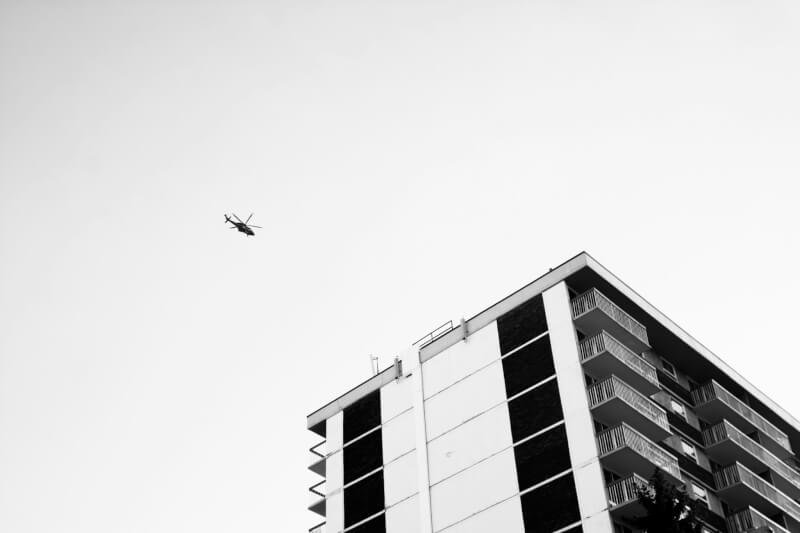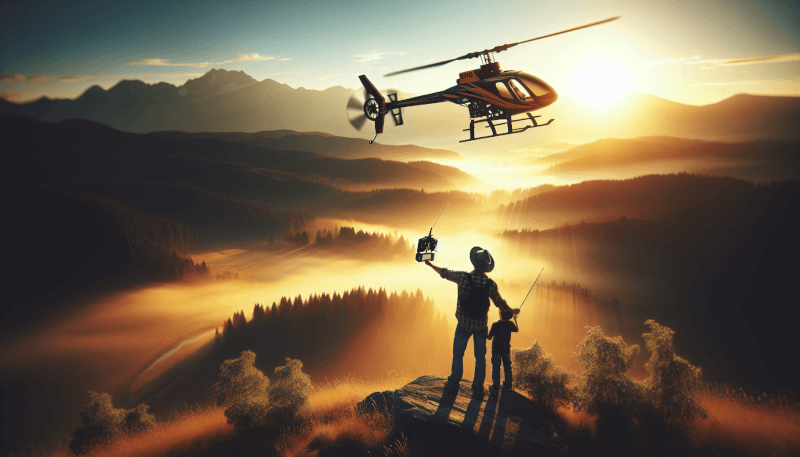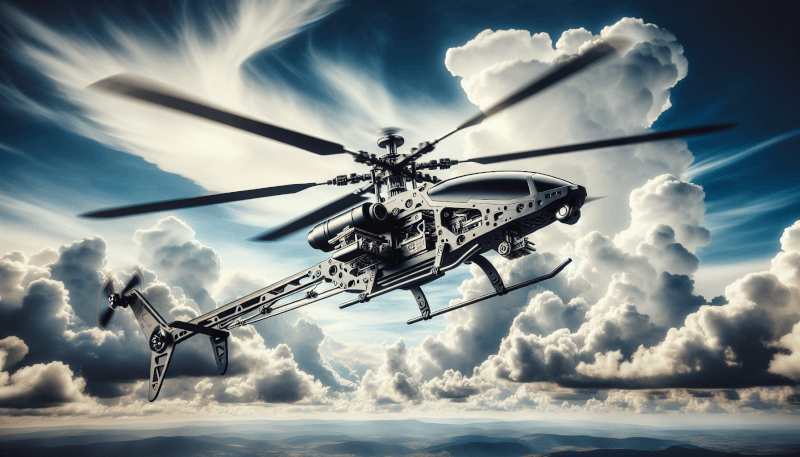So you’ve just purchased your very first RC helicopter and you’re eager to take it for a spin, but you have no idea where to start. Well, fear not, because this beginner’s guide is here to help you navigate the thrilling world of RC helicopter flying. From choosing the right helicopter to mastering the basics of flight controls, this article will provide you with the essential tips and tricks to get you soaring through the sky in no time. Get ready to unleash your inner pilot and dive headfirst into the exciting adventure of flying an RC helicopter.

Choosing the Right RC Helicopter
Considering your skill level
When choosing an RC helicopter, it’s important to consider your skill level. If you’re a beginner, it’s best to start with a basic model that is easy to fly and control. Look for helicopters labeled as “beginner-friendly” or “easy to fly.” These models usually have features such as gyro stabilization, which helps keep the helicopter steady in the air. As you gain more experience and confidence, you can opt for more advanced models with additional features and capabilities.
Deciding on the type of RC helicopter
There are different types of RC helicopters available, each designed for different purposes and flying styles. The two main types are coaxial helicopters and single-rotor helicopters. Coaxial helicopters have two sets of rotors stacked on top of each other, which makes them more stable and easier to control, making them great for beginners. Single-rotor helicopters, on the other hand, offer more agility and maneuverability, but they require more skill to fly.
Evaluating the different features
Before making a purchase, it’s important to evaluate the different features of an RC helicopter. Some features to consider include the number of channels, which determines the helicopter’s control options, and the range of the transmitter, which determines how far the helicopter can fly. Other features to consider include the battery life, the durability of the helicopter, and the availability of spare parts. Take the time to research and compare different models to find the one that best suits your needs and preferences.
Setting a budget
RC helicopters come in a wide range of prices, so it’s important to set a budget before starting your search. Consider how much you’re willing to spend and remember to factor in the cost of any additional accessories or spare parts that you may need. While it can be tempting to go for the cheapest option, keep in mind that higher-quality helicopters often come with better performance and durability. Balancing your budget with your desired features will help you find the best RC helicopter for you.
Understanding the Parts of an RC Helicopter
The main rotor
The main rotor is the most important part of an RC helicopter as it generates the lift needed to keep the helicopter in the air. It consists of two or more rotating blades that spin rapidly. The angle of the blades can be adjusted to control the amount of lift produced, allowing the helicopter to ascend, descend, and change direction.
The tail rotor
The tail rotor is responsible for providing stability and controlling the helicopter’s yaw, which is its ability to rotate around its vertical axis. It counteracts the torque produced by the main rotor, preventing the helicopter from spinning uncontrollably.
The flybar
The flybar is a weighted bar that extends from the rotor blades. It helps stabilize the helicopter during flight by counteracting any sudden movements or vibrations. Some modern helicopters, especially those with gyro stabilization, may not have a flybar.
The receiver
The receiver is the component that receives signals from the transmitter and relays them to the helicopter’s control system. It’s usually located inside the helicopter’s body and is connected to the various control surfaces and motor.
The transmitter
The transmitter is the handheld device that the pilot uses to control the helicopter. It sends signals to the receiver, which then translates them into the corresponding actions of the helicopter. Transmitters have multiple channels, each controlling a different aspect of the helicopter’s movement, such as throttle, yaw, and pitch.
Preparing for Flight
Finding a suitable flying location
Before you can take your RC helicopter for a flight, you need to find a suitable location. Look for open areas, such as parks or fields, that provide plenty of space for the helicopter to maneuver without any obstacles or obstructions.
Checking the weather conditions
Weather conditions play a crucial role in the safety and performance of your RC helicopter. Always check the weather forecast before heading out to fly. Avoid flying in strong winds, rain, or snow, as these conditions can make it difficult to control your helicopter and increase the risk of accidents.
Inspecting the RC helicopter
Before each flight, it’s essential to inspect your RC helicopter for any signs of damage or wear. Check the blades, body, and landing gear for any cracks or loose parts. Ensure that all components are securely in place and that the control surfaces move freely.
Charging the batteries
Most RC helicopters are powered by rechargeable batteries. Make sure to charge the batteries fully before each flight to ensure maximum flight time. Follow the manufacturer’s instructions for the proper charging procedure and use a reliable charger.
Assembling the helicopter if necessary
Some RC helicopters may require assembly before they can be flown. If this is the case, carefully follow the instructions provided by the manufacturer to put the helicopter together correctly. Pay special attention to the attachment of the rotor blades and any other crucial components.
Learning the Controls
Understanding the transmitter
Before you can start flying your RC helicopter, it’s essential to understand how the transmitter works. Familiarize yourself with the various buttons, switches, and knobs on the transmitter and learn their functions. Take the time to read the user manual that comes with your helicopter for detailed instructions on how to use the transmitter.
Getting familiar with the different channels
The transmitter has multiple channels, each controlling a different aspect of the helicopter’s movement. For example, the throttle channel controls the helicopter’s altitude, while the yaw channel controls its rotation. Spend time getting familiar with each channel and its corresponding control to master the helicopter’s movements.
Mastering the throttle control
Throttle control is one of the most crucial aspects of flying an RC helicopter. It determines the helicopter’s altitude and helps maintain a steady hover. Practice gradually increasing and decreasing the throttle while keeping the helicopter at a consistent height.
Practicing yaw control
Yaw control allows the helicopter to rotate around its vertical axis. Practice controlling the yaw channel to smoothly turn the helicopter in both directions. Start with small adjustments and gradually increase the angle of rotation as you become more comfortable.
Learning how to adjust the pitch
Adjusting the pitch of the rotor blades controls the forward or backward movement of the helicopter. Learn how to increase or decrease the pitch to make the helicopter move in different directions. Practice flying in a straight line by adjusting the pitch while maintaining a steady throttle.
Exploring other control options
Once you have a good understanding of the basic controls, you can start exploring other control options, such as adjusting the cyclic pitch or activating the gyro stabilization feature if your helicopter has one. Experiment with these additional controls to discover new flight capabilities and maneuvers.

Basic Flight Maneuvers
Taking off and landing
Mastering takeoffs and landings is essential for any RC helicopter pilot. Start by gradually increasing the throttle to lift the helicopter off the ground. Once in the air, maintain a steady hover and carefully decrease the throttle to initiate a controlled landing. Practice these maneuvers in an open and safe area before attempting more advanced flights.
Hovering in place
Hovering is a fundamental skill for flying an RC helicopter. It requires precise control of the throttle, pitch, and yaw. Practice maintaining a stable hover at various altitudes and experiment with small adjustments to feel the helicopter’s response.
Flying in a straight line
Flying in a straight line involves maintaining a constant heading while adjusting the pitch to control the helicopter’s speed. Start by flying at a slow and steady pace, gradually increasing the speed as you become more comfortable. Focus on keeping the helicopter aligned and smooth during the entire flight.
Turning the helicopter
Learning how to turn your helicopter smoothly is crucial for navigating different flight paths. Practice making both left and right turns by using the yaw control. Start with small, gentle turns and gradually increase the angle and speed as you become more proficient.
Performing gentle climbs and descents
Climbs and descents allow you to control the altitude of your RC helicopter. Practice climbing by gradually increasing the throttle while maintaining a steady hover. To descend, decrease the throttle slowly while monitoring the helicopter’s altitude. Mastering these maneuvers will give you better control over your helicopter in various flight situations.
Practicing Advanced Maneuvers
Flying in different orientations
Once you have mastered the basic flight maneuvers, you can challenge yourself by flying your RC helicopter in different orientations. Practice flying upside down or sideways to improve your control skills and expand your flight capabilities.
Performing loops and rolls
Loops and rolls are impressive aerobatic maneuvers that add excitement to your flights. To perform a loop, climb to a suitable altitude, then pull back on the pitch control to bring the helicopter upside down. As it continues to climb, push the pitch control forward to complete the loop. Rolls involve smoothly rotating the helicopter around its longitudinal axis. Start with small rolls and gradually increase the speed and size of the maneuver.
Executing flips and inverted flight
Flips are similar to loops but are executed in a more aggressive manner. To perform a flip, bring your helicopter to a suitable altitude, then quickly push the pitch control to bring it upside down. Flip the helicopter by rapidly adding full negative pitch and then quickly transitioning to full positive pitch. With practice, you can also attempt flying your helicopter inverted, where the belly of the helicopter faces the sky. This advanced maneuver requires precise control and a thorough understanding of the helicopter’s orientation.
Learning autorotation
Autorotation is a technique used to safely land an RC helicopter in the event of a power failure. When properly executed, it allows the helicopter to descend slowly and land safely without power. Practice autorotation by gradually reducing the throttle while keeping the helicopter level. As you become more confident, experiment with different approaches and controlled landings.
Trying 3D aerobatics
If you’re looking for an adrenaline rush, 3D aerobatics are the way to go. This advanced flying style involves performing extreme maneuvers such as flips, rolls, and tumbles. However, attempting 3D aerobatics requires an expert level of skill and experience. Make sure to practice in a safe and open area with plenty of altitude before attempting any high-energy maneuvers.

Troubleshooting Common Issues
Handling crashes and collisions
Crashes and collisions are an inevitable part of flying RC helicopters, especially when learning new maneuvers. When a crash occurs, immediately assess the damage and make any necessary repairs or replacements. Learn from each crash and use it as an opportunity to improve your flying skills.
Dealing with low battery situations
Running out of battery power during flight can be a frustrating experience. To avoid this issue, keep a close eye on the battery level and plan your flights accordingly. Familiarize yourself with the flight time of your helicopter and set an alarm or timer to remind you when to bring it back for a safe landing.
Addressing control signal interference
Interference from other electronic devices or radio signals can cause a loss of control over your helicopter. If you experience control signal interference, try changing the frequency or channel of your helicopter’s transmitter. Avoid flying in areas with heavy radio frequency interference and be aware of any potential sources of interference.
Fixing mechanical malfunctions
Mechanical malfunctions can occur due to wear and tear or improper maintenance. If you encounter any mechanical issues with your RC helicopter, consult the manufacturer’s instructions or seek assistance from a knowledgeable hobbyist or technician. Carry out any necessary repairs or adjustments to ensure the safe and smooth operation of your helicopter.
Replacing damaged parts
Accidents happen, and parts of your RC helicopter may become damaged or worn out over time. It’s important to replace damaged parts, such as blades or landing gear, to maintain the performance and safety of your helicopter. Keep a stock of spare parts specific to your model and consult the manufacturer’s instructions for proper replacement procedures.
Maintaining Your RC Helicopter
Properly storing the helicopter
When not in use, it’s important to store your RC helicopter properly to protect it from damage and ensure its longevity. Invest in a suitable storage case or box that provides protection against dust, moisture, and physical impact. Store the helicopter in a dry and cool place away from direct sunlight.
Cleaning the helicopter
Regular cleaning is essential to keep your RC helicopter in optimal condition. Use a soft cloth or brush to remove dust and debris from the surface and components. Avoid using harsh chemicals or solvents as they can damage the helicopter’s paint or plastic parts. If necessary, use a mild soap and water solution for more thorough cleaning.
Inspecting and tightening screws and bolts
Regularly inspect the screws and bolts on your RC helicopter to ensure they are tight and secure. Vibration and flight maneuvers can loosen these fasteners over time, which can lead to mechanical issues or even accidents. Use a suitable screwdriver or wrench to tighten any loose screws or bolts as part of your regular maintenance routine.
Lubricating moving parts
To keep the moving parts of your RC helicopter operating smoothly, apply a small amount of lubricant to the appropriate areas. Consult the manufacturer’s instructions for the recommended type of lubricant and application method. Avoid over-lubricating as it can attract dirt and debris, which can affect the performance of the helicopter.
Performing regular maintenance checks
Regular maintenance checks are crucial for ensuring the safe and efficient operation of your RC helicopter. Schedule routine inspections to identify any signs of wear, damage, or deterioration. Check the blades, motors, gears, and other components for any abnormalities. Address any issues promptly to prevent further damage and maintain the longevity of your helicopter.

Safety Considerations
Adhering to local regulations and guidelines
When flying an RC helicopter, it’s important to adhere to local regulations and guidelines. Familiarize yourself with the rules and regulations in your area regarding where and when you can fly your helicopter. Respect any airspace restrictions and fly in designated areas to ensure the safety of yourself and others.
Flying in open and clear areas
Always choose open and clear areas for flying your RC helicopter. Avoid flying near buildings, power lines, or other structures that can pose a risk to your helicopter. Flying in large, open spaces provides more room to maneuver and reduces the chances of accidents or collisions.
Avoiding flying near people and animals
To prevent accidents or injuries, it’s crucial to avoid flying your RC helicopter near people, animals, or vehicles. Respect the privacy and safety of others and make sure you have a clear line of sight of your helicopter at all times.
Using safety equipment
Wearing appropriate safety equipment is essential when flying an RC helicopter. Invest in a good quality pair of safety goggles or glasses to protect your eyes from debris or rotor blades. Consider wearing protective gloves and close-toed shoes to protect your hands and feet.
Being mindful of flyaways
Flyaways occur when the RC helicopter loses control and flies away from the intended flight path. To minimize the risk of flyaways, always maintain a clear line of sight with your helicopter and avoid flying in areas with strong radio interference. Be prepared to regain control in case of a flyaway by staying calm and focusing on bringing the helicopter back to a safe location.
Joining an RC Helicopter Community
Connecting with other enthusiasts
Joining an RC helicopter community is a great way to connect with other enthusiasts and share your passion for flying. Look for local hobbyist groups or clubs in your area where you can meet like-minded individuals, exchange tips and advice, and even arrange group flights.
Attending RC helicopter events
Attending RC helicopter events, such as airshows or competitions, provides an opportunity to see experienced pilots in action and learn new techniques. These events often feature demonstrations, workshops, and vendor booths where you can find the latest RC helicopter models and accessories.
Participating in online forums and discussions
Online forums and discussions are a valuable resource for RC helicopter enthusiasts. Join popular RC helicopter forums and engage in conversations with experienced pilots. These platforms allow you to ask questions, seek advice, and share your own experiences with a global community of hobbyists.
Seeking advice and guidance
If you’re new to flying RC helicopters or want to learn advanced techniques, don’t hesitate to seek advice and guidance from experienced pilots. Reach out to local hobby shops or attend training sessions offered by professionals. Having a mentor or instructor can greatly accelerate your learning curve and help you avoid common mistakes.
Sharing your experiences
As you gain experience and confidence in flying RC helicopters, consider sharing your own experiences and knowledge with others. Create a blog, social media account, or YouTube channel to document your flights, provide tips and tutorials, and connect with fellow enthusiasts. Sharing your journey can inspire and motivate others to take up this exciting hobby.



